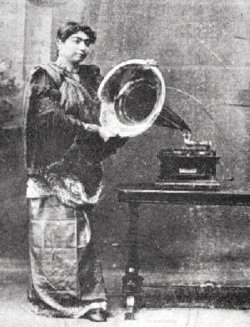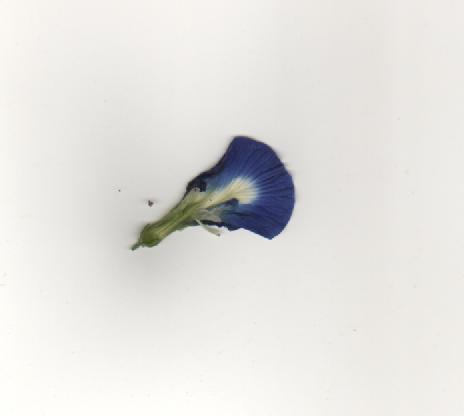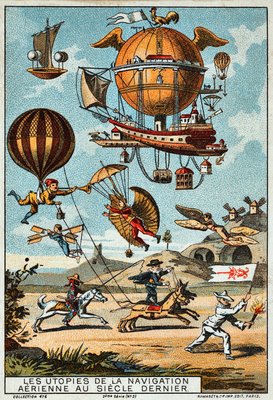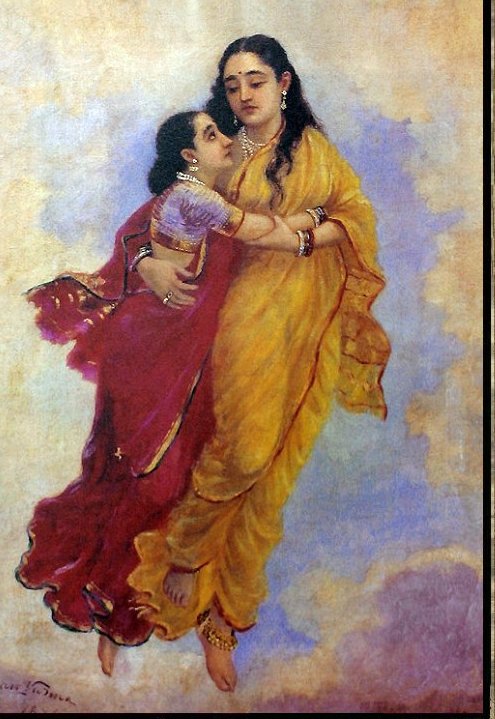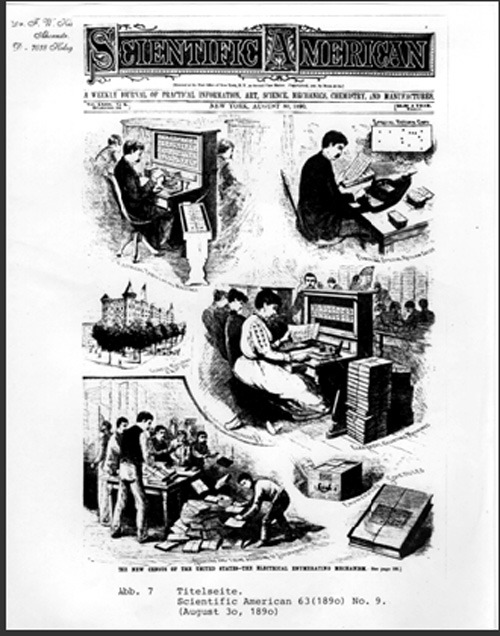1890
young gohar jaan [1]
[2] postcard from the time showing Gowhar Jaan in her medals and in an elaborate saree with sea shells made of pearls, and delicate dark nets falling from her sleeves over her bare arms. [3] Gurusaday Dutt "the living traditions of the distinctive arts of each province existed in an almost unbroken current in its rural areas from remote antiquity"[4]
When the brothers are painting in Bombay, many Brahmain women walk in, to see the divine sight of the gods on earth.
The paintings, when they are completed, are first exhibited in Trivandrum, in a large, unprecedented kind of public exhibition. then they travelled to and were shown in Bombay, before reaching Baroda.
Paintings:
Nala Damayanti
Radha and Madhava
Bharata and the Lion Cub
Arjun and Subhadra
Vishvamitra and Menaka
Shantanu and Ganga
Kamsa Maya
Disrobing of Draupadi
Harischandra and Taramati
Keechak and Sairandhari(also titled: Beauty and the Beast)
Sita Swayamvaram
Birth of Krishna
Devaki and Krishna
Shantanu and Satyavati
Dada buys still camera from scholarship. At Nasik, when the boatmen strike, wrestlers agree to play the ferry. Taking their shoes off and crossing the bridge over the sacred river.
तेलांग
मित्र सुना है तुम फोटोग्राफी करने लगे हो, फिर कामेरा कहाँ है?
कुछ आतंक कारी बंदरों ने लूट लिया.
कौन थे, कितने थे, कुछ ग्यात हुआ?
अन्वेषण जारी है
शायद मैं तुम्हारे अन्वेषण मैं सिद्ध रहूं. काम आऊँ. किंतु जिस युग में चित्र गतीमाया हों, तब तुम मुझे याद करोगे.
अर्थात?
फोटोग्राफी क्या है?
फोटोग्राफी . the formation of an image on a flat surface by an optical device and alchemical method of sensitizing that surface to a light source so the image can be captured permanently.
इस ही बात पर तुम्हें अपने मित्रों से मिलाता हूँ.
'मित्र, यह मेरे वानर सखा हैं. तुम्हारे जाने के बाद केवल यही मित्र थे. क ई वर्षों से तुम्हारी मित्रता की चर्चा करता आया हूँ. किंतु मिलाने के पहले तुम्हें आश्चर्या में डालने की इच्छा थी.
Monkeys are ready with the camera, moving around Hanumanji. Phalke sits with them posing. Telang takes the picture.
He saw those magnificent pictures which were becoming talk of the town- an Indian who could paint just as well as the white man, with all the white man's rules already in place. With no formal art education. It was incredible. Dhundhi was mesmerised by ( name one painting)
And the milk skinned Maharashtrian girl who was all of them, she was Sita, she was Damayanti, she was..Kamala? Kamala wanted to know more about her. Where did she live? How could he paint a- bad woman. How could he even think of having a relationship with her? Govind looked at her affectionately and tried to explain what it meant to have a muse. What it meant to make art. Kamala was angry with how much Govind had observed of the quality of that cheap girls' skin.
Pink nailpolish chemical
That afternoon, Phulla saw the divine Urvashi climb up the temple stairs.
Phulla's veranda, where she sat stringing flowers to make little ornaments for the hair, was situated one third up the length of the stairs, which flowed up like a broad river that thinned in its upper reaches. That morning,the most beautiful fish was making her way up them, gracefully swinging her fin. She was young, probably 12 or so. Dark kohl lined her jewel like eyes and shone on a skin whose radiance would pull the onlooker towards it, and then intimidate him from touching it. Her long lashes swept the stairs as she walked. Soft pebbles of mogra caressed the back of her neck. Her forhead was dusted by a lightly blown patch of vermillion.
When those langorous eyes swept past Phulla, in an instant forgetting her presence, perhaps never noticing it even, Phulla was stung to the quick. She turned her head away from the apparition and looked at the fish-mother instead. The mother's face was craggy, as though the daughter's skin had absorbed all its moisture. If 'Urvashi's' hands were soft and limp, her mothers' had the restlessness of an engineer. In making this perfect picture that stood next to her, the mother had become a dull outline. Her presence was about an absence, her face showed a fear of want. But her hand was clasped in 'Urvashis. She wanted the gift of flight from her.
As Phulla's eyeballs swam, over the mother's hands, along the daughter's, to that beautiful face, again..a sky rose over the earth inside her, like a minaret over a tower. A thorny green bush caught fire inside, and Phulla was singed. Her plump fingers continued to pick white flowers and nothing stirred in her eyes. The girl walked right past her. Still dazed in the trap of fragrance of her flowers and her hair oil, Phulla turned to her own courtyard. Her mother was stoking a fire, very slowly, as if she wanted to be sure that she did not break the sleep that she had gathered to her like a comfortable blanket from the day Phulla took over her work at the stall. This is how it's always been with the mothers of the flower girls at this temple.
The wave having passed, the stairs were stone again. A cat with an absolutely upright tail was slowly taking measure of the courtyard. It felt like the evening had emptied the yard of any signs of life. A hollowed cat, a hollowed mother, a hollow yard, over all of which, the evening had settled in a shroud of small particles. The hollowed out legs of Phulla hurt as she carried utensils to the river for a wash.
The mats were empty. But the katha vachak had started his story in the light of the lamp. Phulla sat on the empty mat with the hope that maybe, by some chance, the story that was told today, would somehow belong to her. Her palm was clutching the packet of vermillion she had bought from Azgar's shop.
But the old man told the story of the big devout bird whose wing got cut off by Ravana impatiently carrying Ram's wife away. Ram was tender with the bird with the broken wing. Phulla breathed impatiently. A virtuous life rewarded with a stray kindness at its very end, no, this is not what she wanted to hear. And an old man who looked like a gaunt bird himself in the light of the lamps. She looked away, this way and that, and then, gritting her teeth against the story that was softening the old storyteller's face, making him maudlin, she began to draw a large red eye in the vermillion she was carrying.
Govind was resting on his arms on one of the empty mats and looking up at the sky, where dull clouds were walking over a stunted moon. Govind shut his eyes and found images falling behind them like coins into a money box. Like broken paintings they fell- the horse at Baroda.. Sir Griffith standing in a corridor.. Just today, in their courtyard, his mother had extended a baby towards him, as though she was saying "Yours". Kamala was standing in the depths behind Ma's large shoulder. Govind's fingers went over the edge of the durrie and sank in the sand, stroking it, imagining Kamala..His eyes opened. Baba's face was so white in the light of the lamp.
The boatmen of Nasik were on strike again. So Govind had also sat on a pahalwan's shoulder to cross the river. It irritated him. Had he not been carrying all that luggage, he would have swum across. Mid river, Chandu Kaka passed by, letting out sharp giggles from where he sat on the shoulders of one of the pahalwans of the Udaseen Akhara. Ahead of him a woman passenger had completey covered her face with her saree, so that no one recognised her in this shameful posture. Govind kept staring her way- who was she? He had an urge to kick at the sides of his mount, like he would at the horse in Baroda, and yell 'giddy up'!
Was that Kaki after all? Even after getting off, Govind waited a full 20 mintues at the ghat, in the hope that if he figured who the woman was travelling with, he would be able to identify her, and he could narrate this story to Kamala at night. Would Kamala laugh?
The fat girl in front of him was going on shaking something in a small pouch. She looked working class, like she'd taken advantage of the situation and made herself comfortable on the empty mats. All her attention was directed at the pouch in her lap. Truth be told, even Govind was impatient with Baba's telling. His voice was not able to travel the distance of the mats. Had Baba's voice been diminished by this open shore? Govind felt like putting up a Ravi Verma painting on the ghat instead- and how the crowds would clamour then. He kept staring at his father.
After washing the dishes, Phulla had broken the water into pieces as she swam to the temple in the middle. She had stayed there, silently, like a fat fish in the water, mourning as she looked at the moon. She had realised that she was trapped in her mother's very ordinary dream. Aeons away from that dreamt up Urvashi.
When Govind hid his face in the black cloth and tried to find his Baba in the mirrors of his camera, he found an empty chair- Baba had left its imprisonment. It was the next morning. Govind was trying to forget what he had thought of the Katha the previous night. He had put the camera between his father and himself. He wanted to capture an image of his father that he could then love in a simple way. But Baba refused this imprisonment. As did Kamala. His hand lightly holding the leg of the camera stand, Govind realised that this small temple town was not the place to keep his machine. He would have to go elsewhere to work it.
From the 1890's, a period that coincided with the "explosion" of postcards in the West, the artist Dhurandhar designed postcards for a local manufacturer, the first Indian to do so. Ethnographic postcards became a popular way for the British to write back home. Dhurnadhar's "Ayah" was widely pirated.
The Laxmi Vilas palace is completed and inaugrated. The queen in whose name and for whom it was made, is long dead. Eclecticism is a primary note of the design. The decorations designed to display skills rather than to achieve a unity of diverse elements, project the unique features of each craft. The devices and motifs, illusionistic or otherwise, and forms which may be organic or geometric, plain or ornate, are assembled with an intent to interject into each other and are curiously held together in what appears to be a heterogenous whole. Perhaps the matching compatibilities of skills and designs neutralise their angularities to form an eclectic togetherness. The mixture of multiple modes, methods and materials, for all its seeming arbitariness, serves the purpose for which the Darbar Hall was designed: to serve as a backdrop, a setting familiar enough for any gathering- a coronation or the daily court, a formal meeting, or a concert or dance soiree; as such it was not to obtrude upon the eyes of the audience with any awe inspiring opulence. In essence it was intended to provide each performance with a choice of trajectories from the multifarious spaces and emblems on its walls.
.. The complex polemic of motifs interwoven in its design is full of meanings other than its architectural ones.. perhaps it broadly suggests a blueprint for a broad polity. G M S
note: the rivalry between photographic drawings and the use of images. how the 'feeling' for photographs comes only gradually. ab
Zunzarrao by G.B. Deval, adaptation of Othello, proved to be very very popular.
Prince of Wales visits India, a nautch performance is held for him. Widespread protests broke out in the country, led by Reverent J Murdoch
